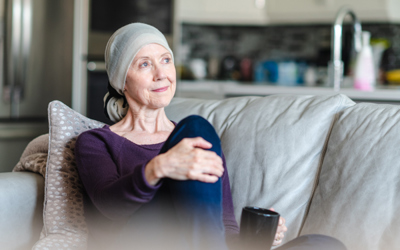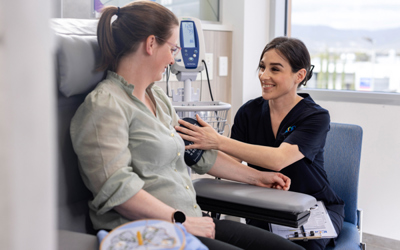What are the treatment options for non-melanoma skin cancers?
The primary treatment options for non-melanoma skin cancers such as squamous cell carcinoma (SCC) and basal cell carcinoma (BCC) include surgery, radiotherapy, cryotherapy, photodynamic therapy, laser surgery, targeted therapy, chemotherapy and immunotherapy. The type of treatment you receive will depend on a number of different considerations, such as the type of non-melanoma skin cancer you have, its stage, your overall health and your treatment preferences. This page aims to give you a comprehensive overview of how non-melanoma skin cancer treatment works.
Surgery for non-melanoma skin cancer
Surgery is the most common treatment for non-melanoma skin cancer. In many cases, surgery may be the only treatment you need.
-
Mohs surgery
Mohs surgery is an option for treatment of non-melanoma skin cancers near your eye, nose, ears and fingers.
The goal of Mohs surgery is to preserve as much healthy skin as possible. To do this, your non-melanoma skin cancer will be removed layer by layer by a specifically trained specialist in Mohs surgery, and checked under a microscope each time. The surgery is complete when there are no cancerous cells left behind. This may be a long process.
Once your non-melanoma skin cancer is removed, the wound can be stitched closed or covered with a skin flap or skin graft:
Skin flap – Nearby skin is moved over the wound
Skin graft – Skin is taken from another body part and stitched over the wound
-
Curettage and electrodesiccation
If you have superficial squamous cell carcinoma or basal cell carcinoma, your cancer might be removed using a sharp spoon-shaped instrument called a curette. An electric current is then applied to the area to destroy any remaining cancer cells. This is known as electrodesiccation.
-
Lymph node dissection
Sometimes, non-melanoma skin cancers can spread to surrounding lymph nodes. If a biopsy has found that the cancer has spread to the lymph nodes, a lymph node dissection may be performed to remove any affected lymph nodes. Removing all the lymph nodes is called a complete lymph node dissection.
Radiotherapy for non-melanoma skin cancer
Radiotherapy is a non-invasive treatment option for basal cell carcinoma and squamous cell carcinoma and is particularly effective for older patients, for those who would prefer to avoid surgery, or if the cancer is in a location where surgery isn’t medically or cosmetically recommended. In some cases, radiotherapy may also be given after surgery to prevent the cancer from coming back or if the cancer is advanced.
Types of radiotherapy commonly used for people with non-melanoma skin cancer include:
Cryotherapy for non-melanoma skin cancer
Cryotherapy involves applying liquid nitrogen onto the non-melanoma skin cancer to freeze and kill non-melanoma skin cancers such as small basal cell carcinomas. This might be repeated multiple times depending on your treatment plan, and you may feel a burning or stinging sensation in the area being treated. Once the cancer is destroyed, new healthy skin will grow over the wound.
Photodynamic therapy for non-melanoma skin cancer
Photodynamic therapy involves applying a gel which makes your non-melanoma cancer sensitive to light. A special light is then directed onto the non-melanoma skin cancer for around eight minutes to destroy it. This may also help to damage blood vessels in the tumour. Photodynamic therapy is commonly used to treat superficial basal cell carcinoma and squamous cell carcinoma in situ.
Laser surgery for non-melanoma skin cancer
Laser surgery is a less common treatment for non-melanoma skin cancer that uses the heat from a laser beam to destroy skin cancer cells. The treatment is typically effective for very superficial basal cell carcinomas and squamous cell carcinoma in situ (Bowen disease).
Chemotherapy for non-melanoma skin cancer
Topical chemotherapy is a common treatment option for non-melanoma skin cancer which involves applying an anti-cancer drug (normally a cream or gel) directly onto the affected area. Because it is only applied to the top layer of the skin, topical chemotherapy is not effective for non-melanoma skin cancer that has spread to areas such as the lymph nodes and surrounding organs.
Common topical chemotherapies that are used to treat non-melanoma skin cancer include:
5-fluorouracil (5-FU) - Commonly used to treat superficial basal cell carcinoma and squamous cell carcinoma in situ (Bowen’s disease), this cream is typically applied twice a day for several weeks. While using this cream, you will need to stay out of the sun or cover up with sunscreen and protective clothing to avoid any exposure to UV radiation.
Immunotherapy for non-melanoma skin cancer
Immunotherapy trains your body’s own immune system to recognise and fight non-melanoma skin cancer cells.
A common type of immunotherapy treatment for non-melanoma skin cancer is called imiquimod. This is a cream which is typically applied directly onto the non-melanoma skin cancer daily for several weeks. It can increase the number of cancer-destroying proteins your skin makes to treat sunspots, superficial basal cell carcinoma and squamous cell carcinoma in situ (Bowen’s disease).
For advanced basal or squamous cell skin cancer, cancer cells may hide from your immune system using checkpoints – proteins that are turned on or off to tell your body what cells needs to be protected or attacked. Checkpoint inhibitors are drugs that can help the immune system to recognise non-melanoma cancer cells and destroy them. This is typically used to treat advanced squamous cell carcinoma.
Common checkpoint inhibitor medicines
Common checkpoint inhibitor immunotherapy drugs used to treat non-melanoma skin cancer include:
-
Cemiplimab
This is a monoclonal antibody that works by attaching to a protein receptor on immune system T cells called PD-1, stimulating them to recognise and attack cancer cells. It is used to treat metastatic or locally advanced cutaneous squamous cell carcinoma and is given by intravenous infusion every 21 days, with each infusion taking about 30 minutes.
-
Avelumab
This is a monoclonal antibody that targets and blocks the activity of the PD-L1 protein on the surface of your immune system T cells. When this pathway is blocked, it stimulates your immune system to find and destroy cancer cells. It is used to treat advanced Merkel cell carcinoma. It is typically given by intravenous infusion every 14 days, with each infusion delivered over 60 minutes.
Targeted therapy for non-melanoma skin cancer
Like other cells, non-melanoma cancer cells are made up of a number of different parts including proteins. Targeted therapies use drugs to destroy specific proteins or gene mutations in advanced non-melanoma cancer cells. Advanced basal cell carcinoma cells can have mutations that are part of a cell signalling pathway (how cells pass instructions to each other) called hedgehog. When the hedgehog pathway is activated, this causes the cancer cells to grow in an uncontrolled, rapid way.
Hedgehog pathway inhibitors are drugs that target this pathway, slowing down the cancer’s growth and spread. They are typically used to treat advanced (metastatic) non-melanoma skin cancers and some advanced basal cell carcinomas when surgery and radiation therapy are not appropriate.
Hedgehog pathway inhibitors include:
Sonidegib – This is taken orally as a tablet twice daily
Vismodegib – This is taken orally as a tablet once daily
Clinical trials for non-melanoma skin cancer
Icon offers a wide range of clinical trials providing patients with access to new and evolving treatments. Clinical trials offer hope and opportunity and contribute to breakthroughs in treatment for future cancer patients.

Treatment by stage of non-melanoma skin cancer
When you are diagnosed with non-melanoma skin cancer, your oncologist will develop your treatment plan as part of a multidisciplinary team based on the size and spread of your cancer.
Common treatment options for each stage of non-melanoma skin cancer include:
Non-melanoma skin cancer that is localised
Treatment for localised non-melanoma skin cancer will depend on the type, size and location of the cancer. Localised squamous cell carcinoma and basal cell carcinoma may be treated with surgery (including Mohs surgery), radiotherapy, curettage and electrodesiccation, cryosurgery and sometimes photodynamic therapy. Treatments such as topical chemotherapy (5-fluorouracil) and topical immunotherapy (imiquimod) are also common options for basal cell carcinoma and squamous cell carcinoma in situ (Bowen disease). Laser therapy is a less common treatment option for non-melanoma skin cancer.
Non-melanoma skin cancer that is metastatic (has spread)
When non-melanoma skin cancer has spread, local therapy is often combined with other treatment options. The most common treatment for advanced squamous cell carcinoma is immunotherapy, while targeted therapy and sometimes immunotherapy are typically used to treat advanced basal cell carcinoma. You may also receive lymph node surgery if your cancer has spread to any lymph nodes. Patients who have evidence of spread should be assessed by a multidisciplinary team of doctors who specialise in the management of non-melanoma skin cancer.













